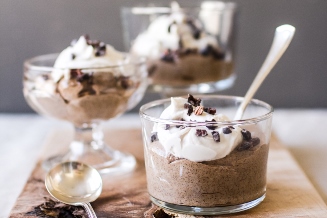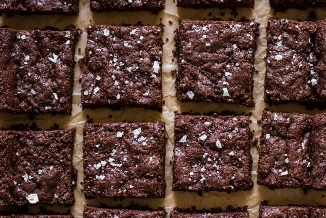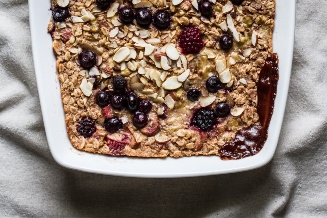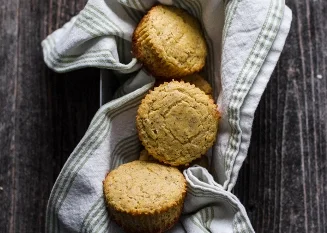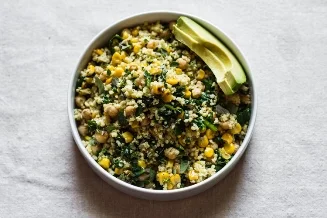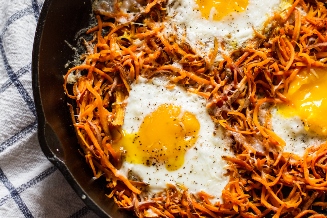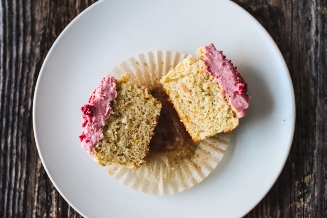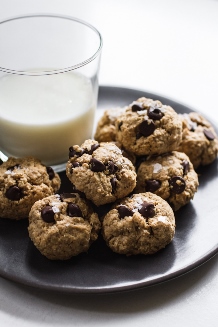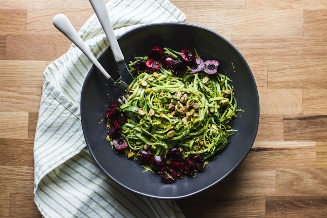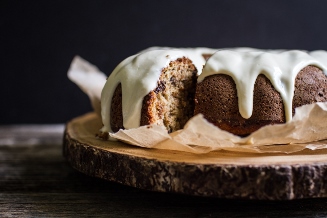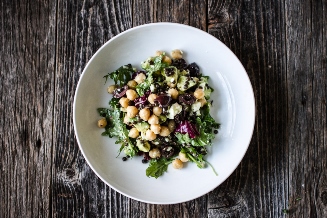The Best Gluten-Free Pizza Crust [& vegan!]
/I never thought the day would come where I’d be posting a recipe for gluten-free pizza. Let alone, grilled gluten-free pizza. And also vegan!
It’s pretty hard to come by gluten-free pizza crust that is actually worth eating. I usually just skip that option on the menu because more often than not they’re dry, crumbly, and/or mealy.
Making gluten-free pizza crust at home was just one of those things I kind of wrote off. Similar to how I initially wrote off creating gluten-free cookies, brownies, and scones. However, I think pizza was the most intimidating.
[The crust is vegan but obviously not this cheese.]
I’m not sure exactly how many trials this took to get just right but I can definitely say it was a lot. I wanted to do something a little different, using as many whole grain flours as possible. I started with a blend of millet flour, quinoa flour, sweet rice flour, and oat flour but couldn’t get it just right.
And while I typically don’t use starches in my flour blends it was apparent that’s what this crust needed. I decided on potato starch and it was crucial in giving the crust a lighter, crisper texture. I thought at first I could use sweet rice flour instead of potato starch but it ended up giving the crust a bit of a pasty texture while chewing. Potato starch worked much more successfully.
But even with the use of potato starch this crust is made up of nearly 75% whole-grain flours, which is pretty uncommon for GF pizza.
And I must admit the texture surpassed my expectations.
So what are the two most important parts of this recipe?
- Make sure your yeast activates and becomes foamy, like the photo above. If it doesn’t activate, your dough won’t rise and that will be bad news for your pizza night.
- Be sure to knead your dough for at least a full 5 minutes. Right around 5 minutes you’ll feel the dough become much softer, smoother, and more pliable. This is crucial!
Here are a few process shots for you to check out:
Kneading.
After the 45 minute rise.
Before rolling out the dough.
After rolling to 1/8-1/4 inch thickness.
Lightly crimping the edges and brushing with oil.
The end result is a thin crust pizza that won’t fall limp with a pretty hefty amount of toppings. It’s crispy from edge to edge but not in a break-your-teeth kind of way. The interior has a soft, bready texture and the flavor has a lot of nuttiness from the oat, quinoa, and millet flours.
Since finalizing the recipe I’m pretty sure this has been made an devoured at least 4 times by Chris + myself but it was also approved by a crowd of non-gluten-free friends.
But wait, there’s more!
You also have the option to GRILL your pizza crust! There are a few more steps involved but it’s totally doable and fun!
This recipe and the rest of the grilled spread you see here was work for a freelance job with Frontier Natural Products Co-op. The other recipes I created and photographed were for Smoked Paprika + Lemon Grilled Asparagus and Grilled Polenta with Caprese Salad.
I highly recommend you head over to their Grill The Goodness site to get the details on how to grill this pizza and the other recipes you see here. You’ll also find 3 other grilling menus with spectacular vegan, vegetarian, and seafood options. And, as you check out each recipe you’ll find $1.50 off coupons for Frontier spices. Can’t beat that!
You can find all of the pizza grilling details and more tips + tricks on Frontier’s Grill the Goodness website!
The Best Gluten-Free Pizza Crust [& vegan!]
gluten-free, vegan // yields 4-6 servings
crust:
- 1 1/4 cups gluten-free oat flour
- 1 cup potato starch, not potato flour
- 2/3 cup quinoa flour
- 2/3 cup millet flour
- 1 teaspoon baking powder
- 1 teaspoon fine grain sea salt
herb mixture:
- 1 1/2 teaspoons Frontier dried oregano
- 1 teaspoon Frontier dried sweet basil
- 1/2 teaspoon Frontier garlic powder
- 1/8 teaspoon Frontier red pepper flakes, optional
- 1/4 teaspoon black pepper
yeast mixture:
- 1 cup + 2 tablespoons unsweetened soymilk, divided
- 2 - 2 ¼ teaspoons dry active yeast, 1 packet - 7 grams
- 1 teaspoon pure cane sugar
- 4 teaspoons ground flax meal
- 3 tablespoons warm water
- 1/4 cup sunflower oil, divided
- In a large mixing bowl [ceramic works well for dough] stir together the oat flour, potato starch, quinoa flour, millet flour, baking powder, salt, herbs, garlic, red pepper flakes, and black pepper until well mixed. Set aside.
- Place soymilk in a small saucepan and gently warm over low heat until it reaches 105-115 degrees. It will feel just warm but not hot.
- Pour 3/4 cup of the milk into a cereal-sized bowl, sprinkle the yeast over top, and then the sugar. Whisk for just a few seconds then let sit undisturbed for 10 minutes. The yeast should rise and become very foamy once activated. If it does not become foamy it has not activated and you need to start this step over. It is most likely due to the milk being too hot or too cold. If it’s too hot the milk will kill the yeast.
- While the yeast mixture rests, whisk together the flax and water for 20-30 seconds until it starts to thicken. Set aside for 5-10 minutes. The flax mixture should be thick and gelatinous in texture after sitting.
- Form a well in the center of the flour mixture with your hand pour in 3 tablespoons of oil, the flax mixture, and the yeast mixture. Stir with a large spoon until the mixture is combined. It will be dry and crumbly and not dough-like at this point.
- Slowly drizzle in leftover warm milk [about 1T at a time] and knead in the bowl until the mixture comes together and forms a dough ball. About 1 minute. I used just over 1/4 cup extra milk, but you may need slightly more/less.
- Sprinkle a very light coating of oat flour onto a hard, flat surface and turn the dough out onto the surface. Knead with both hands—folding over twice while pressing with both palms then turning 180 degrees—for 5-7 minutes. Do not skimp on the kneading. Set a timer to be sure you hit the 5 minute mark. Feel of the dough:The dough will feel rough and grainy at first but once you hit the 5 minute mark it should start to soften and feel smooth to the touch. The dough should have the texture of Play-Doh and feel slightly springy and stretchy when you’re done. It should be on the verge of being sticky while you knead the dough, so avoid over-flouring your surface. If the dough is cracked and feels dry, knead a bit of milk into it until soft and smooth.
- Once soft and smooth form into a ball, place in your mixing bowl, and drizzle on about 1-2 teaspoons of oil. Rub oil over the dough. Cover with a towel and place in a non-drafty, warm spot [ideally 75-80 degrees], undisturbed for 45 minutes. The dough will increase in size by about 75%. It will most likely not fully double in size.
- Preheat your oven to 425 degrees Fahrenheit. Place a pizza pan or baking sheet in the top oven to preheat.
- Score the dough into 2 or 3 segments, remove one, cover the bowl with the towel, then knead for about 30 seconds until smooth. When you start to knead the dough may feel a bit crumbly but it will quickly return to its smooth state.
- Place dough on a large sheet of parchment paper [to fit your pan] and gently roll the dough out between 1/8 - 1/4 inch in thickness. Be sure the dough is rolled evenly and thinly. The dough should roll easily and hold together very well. If the edges crack, lightly crimp them together with your fingers or slice away with a knife. But avoid forming a thick edge.
- Brush the entire surface and edges with a light coating of oil.
- Place the rolled out dough [with the parchment] onto the hot pan and bake for 14-16 minutes until stiff and golden brown around the edges. Remove the pizza and top as desired. Bake for another few minutes until the cheese is melted and toppings are hot. Remove and let rest for about 3 minutes then slice with a large chopping knife and serve.
- Repeat with remaining dough.
Tips + Tricks:
I like to use my oven for proofing the dough. I turn the oven light on about 20 minutes prior to placing it in the oven to lightly warm. I place the towel on top of the bowl and place it in the oven on the bottom rack for 45 minutes. This helps keep a constant warm temperature and avoids any drafts.
Oat, quinoa, and millet flour can all be easily ground at home. You can grind oat flour from raw oat groats, steel cut oats, Scottish oats, or rolled oats. Grind quinoa + millet from their whole-grain, raw form. Place each [separately] in a high powered blender, or other small grinding device [my coffee grinder even works well!]. Grind until soft and flour-like in texture, pulsing if needed to avoid the flour becoming hot and creating moisture. If the flour feels a bit gritty sift through a fine mesh strainer to remove any larger pieces. I like to grind in 1 cup batches. Spoon the flour into a dry measuring cup and level off with a knife. Store leftover flour in a sealed container in the fridge for 4-6 weeks.
Beyond excited that grilling season has finally arrived.
Enjoy!
Ashley
*This post was part of a paid freelance job for Frontier Natural Products Co-op.

![The Best Gluten-Free Pizza [& vegan!] | edibleperspective.com #vegan #glutenfree](https://images.squarespace-cdn.com/content/v1/546ab118e4b020f024f62077/1425342761911-PQ56LN734DYK6TAB2XNB/Windows-Live-Writer-5fb93e236023_6BA9-)
![The Best Gluten-Free Pizza [& vegan!] | edibleperspective.com #vegan #glutenfree](https://images.squarespace-cdn.com/content/v1/546ab118e4b020f024f62077/1425342762111-DAG21566KKJWCIJWK73R/Windows-Live-Writer-5fb93e236023_6BA9-)
![The Best Gluten-Free Pizza [& vegan!] | edibleperspective.com #vegan #glutenfree](https://images.squarespace-cdn.com/content/v1/546ab118e4b020f024f62077/1425342762316-1DACE8AE5IOB4YK16NVS/Windows-Live-Writer-5fb93e236023_6BA9-)
![The Best Gluten-Free Pizza [& vegan!] | edibleperspective.com #vegan #glutenfree](https://images.squarespace-cdn.com/content/v1/546ab118e4b020f024f62077/1425342762514-3PYHL2VF44G1O4LBLMCS/Windows-Live-Writer-5fb93e236023_6BA9-)
![The Best Gluten-Free Pizza [& vegan!] | edibleperspective.com #vegan #glutenfree](https://images.squarespace-cdn.com/content/v1/546ab118e4b020f024f62077/1425342762764-CTD84R8QUMP7F4UGEJ2S/Windows-Live-Writer-5fb93e236023_6BA9-)
![The Best Gluten-Free Pizza [& vegan!] | edibleperspective.com #vegan #glutenfree](https://images.squarespace-cdn.com/content/v1/546ab118e4b020f024f62077/1425342762914-S5QC50KZ9YJFHMX74HVB/Windows-Live-Writer-5fb93e236023_6BA9-)
![The Best Gluten-Free Pizza [& vegan!] | edibleperspective.com #vegan #glutenfree](https://images.squarespace-cdn.com/content/v1/546ab118e4b020f024f62077/1425342763116-93BW5TM66OYTQEMN789P/Windows-Live-Writer-5fb93e236023_6BA9-)
![The Best Gluten-Free Pizza [& vegan!] | edibleperspective.com #vegan #glutenfree](https://images.squarespace-cdn.com/content/v1/546ab118e4b020f024f62077/1425342763323-4FSWZBLM3G3LS9FJKMCS/Windows-Live-Writer-5fb93e236023_6BA9-)
![The Best Gluten-Free Pizza [& vegan!] | edibleperspective.com #vegan #glutenfree](https://images.squarespace-cdn.com/content/v1/546ab118e4b020f024f62077/1425342763523-P66L4YOXXJBAJRBLWM1D/Windows-Live-Writer-5fb93e236023_6BA9-)
![The Best Gluten-Free Pizza [& vegan!] | edibleperspective.com #vegan #glutenfree](https://images.squarespace-cdn.com/content/v1/546ab118e4b020f024f62077/1425342763753-8JTX6QZYOH6BYD6VBIZ1/Windows-Live-Writer-5fb93e236023_6BA9-)
![The Best Gluten-Free Pizza [& vegan!] | edibleperspective.com #vegan #glutenfree](https://images.squarespace-cdn.com/content/v1/546ab118e4b020f024f62077/1425342763919-OT262SRZMNGGGQY1L94L/Windows-Live-Writer-5fb93e236023_6BA9-)














